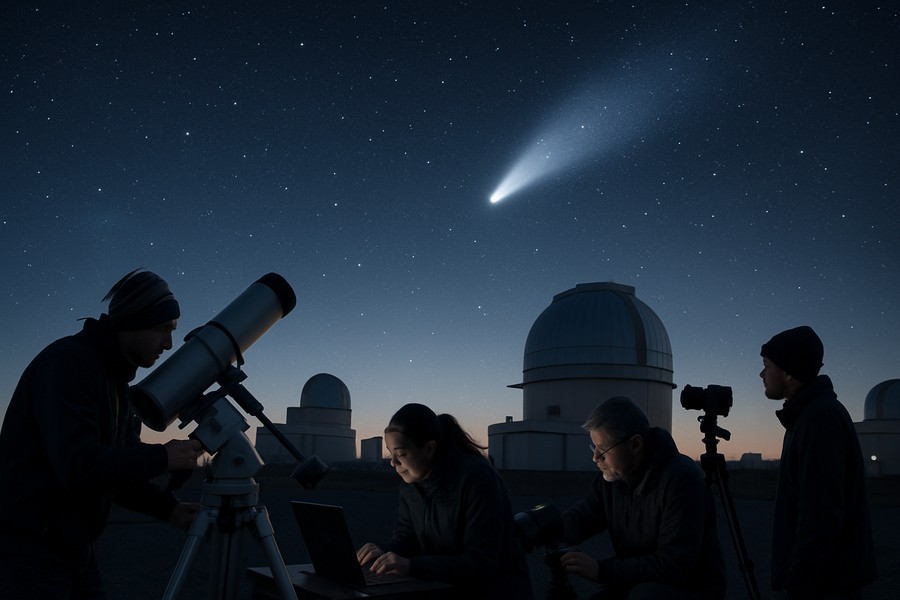
Global Coalition Launches Surveillance of Intriguing Space Object, 3I/ATLAS
An announcement has revealed that a group endorsed by a global organization focused on our planet's safety from space objects has launched a new initiative. This campaign targets the interstellar object known as 3I/ATLAS.
The organization, a collaborative effort of organizations and individual astronomers worldwide, works together to detect, track, and understand potentially dangerous asteroids and Near-Earth Objects. The initiative marks the first time 3I/ATLAS has been the focus of such a campaign.
Announcement Details
The organization made the following announcement on the day of the solar conjunction of 3I/ATLAS relative to Earth:
"Comets present unique challenges for accurate astrometric measurements and orbit predictions. Cometary bodies are extended with morphological features (comae and tails) that can systematically pull their centroid measurements off their central brightness peak, presenting challenges to estimate comet trajectories.
We announce a comet campaign from November 27, 2025, through January 27, 2026, to introduce methods for improving astrometry from comet observations. The campaign will target comet 3I/ATLAS (C/2025 N1) to exercise the capability of the observing community to extract accurate astrometry. To prepare for the campaign, we will hold a workshop on techniques to correctly measure comet astrometry.
Registration is required by November 7th for the workshop, and only those participants that attend the workshop can participate in the campaign."
Special Characteristics of 3I/ATLAS
3I/ATLAS has shown eight intriguing characteristics, earning it a rank of 4 out of 10 on a scale that evaluates the possibility of a technological origin:
- Its trajectory is aligned to within 5 degrees with the ecliptic plane of the planets around the Sun, with a likelihood of 0.2%.
- During July and August 2025, it displayed a sunward jet (anti-tail) that is not an optical illusion from geometric perspective, unlike familiar comets.
- Its nucleus is about a million times more massive than 1I/`Oumuamua and a thousand times more massive than 2I/Borisov, while moving faster than both, altogether with a likelihood of less than 0.1%.
- Its arrival time was fine-tuned to bring it within tens of millions of kilometers from Mars, Venus, and Jupiter and be unobservable from Earth at perihelion, with a likelihood of 0.005%.
- The gas plume around 3I/ATLAS contains much more nickel than iron (as found in industrially-produced nickel alloys) and a nickel to cyanide ratio that is orders of magnitude larger than that of all known comets, including 2I/Borisov, with a likelihood below 1%.
- The gas plume of 3I/ATLAS contains only 4% water by mass, a primary constituent of familiar comets.
- 3I/ATLAS showed extreme negative polarization, unprecedented for all known comets, including 2I/Borisov, with a likelihood below 1%.
- 3I/ATLAS arrived from a direction coincident with the radio “Wow! Signal” to within 9 degrees, with a likelihood of 0.6%.
Multiplying these small probabilities yields a cumulative likelihood lower than a part in ten quadrillion. It therefore makes sense to use all available observational assets on Earth and in space in order to decipher the nature of 3I/ATLAS, as planned by the organization.
Current Limitations and Future Possibilities
Regrettably, we currently lack a spacecraft that could intercept 3I/ATLAS and study it up close. This would require advance planning and early detection to give a spacecraft ample time to intersect the path of 3I/ATLAS. It was calculated that if a certain spacecraft near Jupiter had its initial fuel supply, it could have intercepted 3I/ATLAS at its closest approach to Jupiter on March 16, 2026.
If 3I/ATLAS carried technology, the clearest signature would be a maneuver or the release of mini-probes near perihelion on October 29, 2025. An impulse in the direction of the peak velocity or opposite to it, would maximize the gain or loss of kinetic energy. As a result of this so-called Oberth effect, it is most energy-efficient for a spacecraft engine to burn its fuel at perihelion. If 3I/ATLAS is a massive mothership, it will likely continue along its original gravitational path and ultimately exit the Solar system, while releasing mini-probes near perihelion that might take advantage of the Sun’s gravitational assist as they maneuver towards planets like the Earth.
It is hoped that by December 19, 2025, when 3I/ATLAS will be closest to Earth, we will know more about this intriguing interstellar object.
